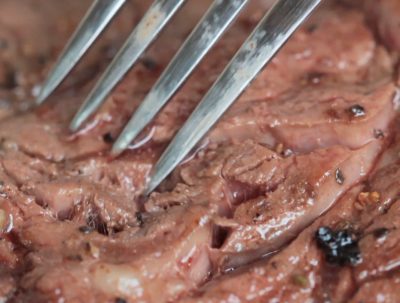 Do you remember beef tasting better years ago than it does today? I do. It took me ten years of searching, but I discovered why. It’s not cooking technique, as important as that is. It’s not necessarily the place you buy beef, either. Lots of expensive beef is only so-so. Even where I live, on Manitoulin Island, Canada – arguably the beef cattle capital of Ontario – exceptional beef isn’t easy to find. In the end my quest for a great steak eventually led to one particular farming family here on Manitoulin. That’s one of their steaks to the left.
Do you remember beef tasting better years ago than it does today? I do. It took me ten years of searching, but I discovered why. It’s not cooking technique, as important as that is. It’s not necessarily the place you buy beef, either. Lots of expensive beef is only so-so. Even where I live, on Manitoulin Island, Canada – arguably the beef cattle capital of Ontario – exceptional beef isn’t easy to find. In the end my quest for a great steak eventually led to one particular farming family here on Manitoulin. That’s one of their steaks to the left.
Jim and Birgit Martin are Manitoulin Island farmers who trace their farming heritage back ten generations. They were also the first farmers I met who agreed to try an idea I had for recapturing the kind of beef experience I used to enjoy growing up. Back when I was a kid in the 1970s, I remember tender, exceptional steaks cooked by my dad on the barbecue. No marinade, no steak sauce, just great beef. Somehow the supermarket steaks I’d bought over the years as a man never, ever tasted that good. Was it just my imagination? Was I fondly remembering beef that wasn’t really better than today’s? I decided to ask some old timers:
“Did beef taste better than it does now?”
“You bet,” one old meat man told me. “Supermarket beef doesn’t taste as good as it used to. Not even close. You really notice it with the steaks, and the difference goes back to aging. Even regular supermarket beef up to the 70s was dry aged. All that changed in the 1980s when the meat business dropped dry aging to boost profits, putting beef in plastic as soon as it left the packing plant. They say it’s supposed to “wet age” in that plastic as it travels in trucks to the stores, but that’s nonsense. You can’t beat dry aging.”
So, what is dry aging? It’s the practice of letting sides of beef hang in a cold place (a degree or two above freezing) for at least 21 days. Was that it? Was lack of dry aging the reason supermarket beef today never tastes as good as I remember?
After ten years of buying local beef here on Manitoulin (it tasted no different than supermarket beef and was sometimes quite a bit tougher depending on who I bought it from), I met Jim and Birgit Martin. They were the only farmers I’d met on the Island who would consider raising their cattle so the beef could be dry-aged for the 30 days I was told was necessary to get that old-time taste. It takes extra feeding and an extra fat covering on a carcass for long-term dry-aging to even be possible. Back in 2000 they’d never done long-term dry aging before, but they agreed to try when I asked them.
The first mouthful of that first dry-aged steak from the side of Martin beef I bought in 2000 brought me back to 1974, around the dinner table eating a nice big T-bone that my dad had barbecued. That old-time taste hadn’t been in my imagination after all. It’s was real and I discovered how to get it. I remember having some friends over for a steak dinner once, and when it came time to serve the meat the mother of the family warned us that she only wanted a little. “I never eat much beef”, she told me. Twenty minutes later she was asking for more and wondering what we’d done to make the beef taste so good.
It’s been 18 years since I convinced Jim and Birgit to dry age beef for me, and now they do it all the time. In fact, when I order a side of beef from them I ask that it be aged for 60 days. That’s way longer than most, and I ask for this treatment because of something interesting I discovered in my experiments.
 Once you get past 45 days of dry aging, an exceptional flavour kicks in. You really don’t know what good beef tastes like unless you’ve tried some that’s been aged longer than 45 days. It’s not just that this beef is more tender because of the aging. Even the stewing beef is tender, but it’s also that the beef takes on a much better flavour. The flavour is so good, some people don’t even add salt. Even the ground beef tastes better. That’s a patty of some of the Martin’s dry-aged beef cooking on our grill to the right. The funny thing is, butchers are rarely on board with extreme dry aging.
Once you get past 45 days of dry aging, an exceptional flavour kicks in. You really don’t know what good beef tastes like unless you’ve tried some that’s been aged longer than 45 days. It’s not just that this beef is more tender because of the aging. Even the stewing beef is tender, but it’s also that the beef takes on a much better flavour. The flavour is so good, some people don’t even add salt. Even the ground beef tastes better. That’s a patty of some of the Martin’s dry-aged beef cooking on our grill to the right. The funny thing is, butchers are rarely on board with extreme dry aging.
There may be exceptions, but almost every butcher I’ve talked to says that aging for more than two weeks makes no difference to taste. Apparently, they’re even taught this in butcher school. I don’t know what to say, except “try the stuff”. Dry aging up to and beyond 30 days makes beef that’s entirely better. Once you go past 45 days, it’s shockingly good.
 That one request of mine for Jim and Birgit to age some beef has turned into a whole new direction for their farm and mine, too. Instead of selling live animals into the commodity market, we’ve created our own brand of premium, dry-aged beef together (www.pureislandbeef.com). I created the logo and website, and we ship across Ontario to a loyal group of repeat customers and small butcher shops who buy from us directly.
That one request of mine for Jim and Birgit to age some beef has turned into a whole new direction for their farm and mine, too. Instead of selling live animals into the commodity market, we’ve created our own brand of premium, dry-aged beef together (www.pureislandbeef.com). I created the logo and website, and we ship across Ontario to a loyal group of repeat customers and small butcher shops who buy from us directly.
The Pure Island logo is even on the window of The Healthy Butcher on Queen Street in Toronto. If you look closely you can see it at the bottom right hand corner of the store window. Not bad for a couple of family farms on an island in the middle of nowhere, right?
Click below to watch a video I made in June when the pasture was growing vigorously. You can see cattle at our place and learn about a trick I use to get the most from the pasture with rotational grazing.












